Dacă ai întrerupt vreodată o scufundare din cauza curenților puternici sau a aerului scăzut, înțelegi de ce un scooter subacvatic fiabil este mai mult un instrument decât o jucărie. Scooterul potrivit face o diferență uriașă, permițându-ți să explorezi situri masive și să gestionezi echipamente grele cu mult mai puțin efort. Acest ghid merge direct la ceea ce scafandrii serioși trebuie să știe, concentrându-se pe detaliile practice: care specificații de performanță contează cu adevărat dincolo de viteză, cum să manevrezi mașina cu precizie și cum să construiești un set-up care să se potrivească muncii pe care o faci.
Cum Îmbunătățește un Scooter Subacvatic Scufundările Profesionale și Tehnice
Un scooter subacvatic (DPV) este un instrument practic care îmbunătățește direct execuția scufundării prin creșterea eficienței, a razei de acțiune și a siguranței. Iată cele patru avantaje principale specifice scufundărilor serioase și tehnice.
Reducerea Consumului de Aer pentru Scufundări Mai Lungi
Cel mai direct beneficiu al utilizării unui scooter subacvatic este că folosești mai puțin aer. Când înoți cu aripioarele, corpul tău muncește din greu, ceea ce te face să respiri mai greu și mai frecvent. Un scooter face munca fizică de propulsie pentru tine, astfel încât corpul tău poate rămâne într-o stare mai relaxată. Această stare fizică mai calmă înseamnă că respiri mai lent și mai eficient.
Această eficiență are un impact real și practic asupra rezervelor tale de gaz. Este comun ca rata de consum a aerului unui scafandru să scadă cu o treime sau chiar mai mult atunci când folosește corect un scooter. Aerul economisit poate fi folosit pentru a-ți prelungi timpul petrecut pe fund și a vedea mai mult dintr-un loc de scufundare. Pentru scafandrii tehnici, adaugă o cantitate semnificativă de gaz la rezerva de siguranță, esențială pentru opririle de decomprimare sau pentru gestionarea problemelor neașteptate.
Acoperă Mai Multă Distanță și Gestionează Curenții
Multe locuri de scufundare, cum ar fi epave mari sau sisteme lungi de recif, sunt pur și simplu prea mari pentru a fi văzute într-o singură scufundare dacă înoți doar cu labe. Un scooter îți permite să acoperi mult mai mult teren. În timp ce un scafandru poate înota cu mai puțin de un nod, un scooter poate călători cu ușurință cu două noduri sau mai mult. Aceasta înseamnă că ai putea explora întreaga lungime a unei epave precum SS President Coolidge într-o singură scufundare, ceva ce altfel ar fi imposibil.
Scooterele fac, de asemenea, posibilă scufundarea în condiții care ar fi foarte dificile cu aripioare. Înotul împotriva unui curent de un nod este extrem de obositor și nesustenabil. Un scooter îți oferă puterea de a trece prin curenți moderați care altfel te-ar putea forța să anulezi o scufundare, oferindu-ți mai multe oportunități de a explora locuri care necesită condiții specifice.
Transportă Echipament Greu și Voluminos Fără Efort
Un scooter face întreaga scufundare mai puțin obositoare prin transportul eficient al echipamentului greu și voluminos. Acest lucru este deosebit de util pentru:
- Scafandri Tehnici: Mișcarea prin apă cu două butelii și mai multe stadii necesită mult efort. Un scooter preia propulsia, făcând configurația voluminoasă mult mai ușor de gestionat, astfel încât să ajungi la adâncimea maximă simțindu-te odihnit.
- Fotografi Subacvatici: Un scooter acționează ca o platformă stabilă pentru capturarea unor videoclipuri line, cu aspect profesional, eliminând imaginile tremurate cauzate adesea de mișcarea aripioarelor. De asemenea, transportă cu ușurință echipamentele grele de cameră.
- Scafandri științifici: Uneltele de cercetare precum echipamentele cu senzori, containerele pentru probe sau rigurile de camere pot fi grele și incomode. O trotinetă transportă acest echipament, permițând scafandrului să-și concentreze energia și atenția asupra sarcinii de cercetare.
Crește siguranța și asistă alți scafandri
O trotinetă este un echipament important de siguranță care sporește siguranța scafandrului în mai multe moduri cheie:
- Reduce oboseala: Prin minimizarea efortului fizic, o trotinetă scade riscul problemelor legate de suprasolicitare și consum ridicat de gaz, prevenind eficient problemele înainte să apară.
- Permite ieșiri mai rapide: Într-o situație neașteptată (cum ar fi schimbarea vremii sau o problemă tehnică), o trotinetă poate scurta semnificativ timpul necesar pentru a reveni la barcă sau la țărm, reducând expunerea.
- Îmbunătățește asistența colegilor: Oferă cea mai eficientă modalitate de a tracta un scafandru obosit sau aflat în dificultate către siguranță. Aceasta protejează salvatorul de epuizarea periculoasă, un risc comun în scenariile de salvare fără asistență.
O trotinetă subacvatică este un instrument esențial pentru scufundări solicitante, iar alegerea celei potrivite începe cu o privire atentă asupra specificațiilor tehnice.

Specificații de bază ale unei trotinete subacvatice profesionale
Evaluarea unui profesionist asupra unei trotinete merge mult mai adânc decât viteza maximă și raza de acțiune publicitate. Necesită o privire atentă asupra detaliilor specifice din design și inginerie care determină controlul, fiabilitatea și manevrabilitatea reală a mașinii.
Prioritatea performanței: De ce controlul contează mai mult decât viteza
Pentru orice scufundare tehnică sau complexă, controlul precis al vitezei este mult mai valoros decât o viteză maximă mare. Deși viteza este utilă, majoritatea lucrărilor profesionale de scufundare—fie că este vorba de cercetarea unui recif sau navigarea în interiorul unei epave—se desfășoară într-un ritm lent și deliberat. Performanța reală a unei trotinete constă în capacitatea sa de a regla fin tracțiunea.
Trotinetele subacvatice de gamă superioară realizează acest lucru cu un declanșator de viteză variabilă, care funcționează asemănător cu accelerația unei mașini, permițând ajustări subtile. Acest nivel de control este esențial pentru:
- Scufundări în echipă: Vă permite să potriviți precis ritmul cu prietenii pentru a menține formația echipei.
- Manișvre delicate: Puteți încetini aproape până la oprire pentru a naviga cu grijă prin pasaje strâmte sau pentru a vă apropia de viața marină fără a provoca deranj.
-
Eficiența bateriei: O funcționare lină și constantă consumă semnificativ mai puțină energie decât opririle și pornirile frecvente.
Când evaluați un model, prioritizați răspunsul și raza de acțiune a controlului vitezei în detrimentul vitezei maxime publicitate.
Sistemul de putere: baterie, timp de ardere și logistică
Sistemul de baterie al unei trotinete determină raza sa de acțiune și fezabilitatea logistică, făcându-l o componentă critică de înțeles.
Timp de ardere publicitat vs. realist
Timpul de ardere publicitat de un producător este de obicei o cifră optimă obținută la viteză redusă. Timpul real de ardere va fi influențat de mai mulți factori:
- Setarea Vitezei: Consumul de energie crește exponențial la viteze mai mari. Funcționarea la turație maximă poate epuiza o baterie de mai mult de două ori mai repede decât funcționarea la jumătate de turație.
- Rezistența Scafandrului: Dimensiunea ta fizică și cantitatea de echipament pe care o porți creează rezistență pe care motorul trebuie să o depășească.
-
Condiții de Apă: Înaintarea împotriva curentului necesită mult mai multă putere decât deplasarea cu curentul.
Pentru o planificare conservatoare a scufundărilor, este înțelept să lucrezi cu 70-80% din timpul de funcționare declarat de producător și să reduci această cifră și mai mult dacă te aștepți la condiții adverse sau porți echipament greu.
Tipul Bateriei și Reglementările Companiilor Aeriene
Scooterele moderne de performanță folosesc universal baterii cu litiu-ion (Li-ion) pentru densitatea lor excelentă de energie — oferă cea mai mare putere pentru cea mai mică greutate.
Totuși, aceste baterii sunt reglementate pentru transportul aerian. Majoritatea companiilor aeriene limitează bateriile la 100 watt-oră (Wh) și cer ca acestea să fie transportate în bagajul de mână. Pentru a respecta aceste reguli, mulți producători fabrică baterii modulare în care fiecare secțiune este sub limita de 100 Wh, permițându-le să fie transportate legal cu avionul și asamblate la destinație.
Baterii Schimbabile pentru Zile cu Mai Multe Scufundări
Pentru zile cu mai multe scufundări cu scooterul sau în expediții cu oportunități limitate de încărcare, modelele cu baterii schimbabile la cald oferă un avantaj logistic semnificativ. Această caracteristică îți permite să schimbi rapid o baterie descărcată cu una nouă între scufundări, minimizând timpul de nefuncționare.
Fiabilitatea Structurală: Adâncime, Materiale și Garnituri
Integritatea structurală a unui scooter este fundamentală pentru fiabilitatea sa și siguranța ta.
- Modele Recreaționale sunt în general evaluate până la 40 de metri (130 ft), aliniindu-se cu limitele standard ale scufundărilor sportive.
- Modele Tehnice & de Expediție sunt proiectate pentru scufundări adânci, cu ratinguri de adâncime de 100 de metri (330 ft) sau mai mult.
Depășirea ratingului de adâncime al unui scooter poate duce la o defecțiune catastrofală a carcasei din cauza presiunii extreme.
Materialele de construcție sunt un indicator cheie al durabilității. Scooterele tehnice de înaltă calitate sunt de obicei prelucrate din aluminiu de calitate aerospațială pentru rezistența și capacitatea sa de a rezista presiunii. În contrast, modelele mai ușoare, orientate spre călătorii, folosesc adesea polimeri sau compozite cu impact ridicat pentru a reduce greutatea.
În plus, căutați caracteristici robuste de design, cum ar fi garnituri duble O-ring pe toate compartimentele și un design în care motorul și bateria sunt în module separate, etanșate. Această compartimentare poate preveni ca o singură scurgere să cauzeze o defecțiune totală a unității.
Dinamica Manevrării: Flotabilitate și Reglaj
Pentru o manevrare optimă și un efort minim, un scooter trebuie reglat pentru a fi perfect neutru în apă. Un scooter echilibrat corespunzător va pluti la adâncimea sa când este eliberat, permițând un control ușor cu o singură mână.
Urmărește acest proces pentru a-ți regla scooterul:
- Test inițial: Asamblează scooterul și pune-l în apă (ideal într-o piscină) pentru a vedea flotabilitatea naturală.
- Adaugă sau elimină greutate: Majoritatea modelelor profesionale au puncte desemnate pentru atașarea greutăților mici de ajustare. Ajustează-le până când scooterul stă nivelat, fără să se scufunde sau să se ridice.
- Ajustează pentru tipul de apă: Amintește-ți că un scooter ajustat pentru apă sărată va fi negativ în apă dulce. Va trebui să îl reajustezi dacă schimbi mediul.
Un scooter bine ajustat se simte ușor de manevrat, permițându-ți să te concentrezi pe scufundare în sine.
Tehnici avansate pentru scooter subacvatic și protocoale de siguranță
Un scooter este la fel de bun ca și scafandrul care îl operează. Dincolo de specificațiile tehnice, performanța ta reală depinde de obiceiuri bune, control precis și de știința modului de a reacționa când apar probleme. Această secțiune acoperă abilitățile esențiale pentru operarea în siguranță și eficientă a unui scooter.
Verificarea sistemelor înainte de scufundare
Această verificare este la fel de importantă ca inspectarea propriului regulator și trebuie făcută înainte de fiecare scufundare. O rutină constantă în care atingi și confirmi fizic fiecare componentă ajută la formarea unor obiceiuri bune și asigură că problemele mici sunt descoperite înainte să devină probleme serioase sub apă.
- Integritatea garniturilor: Verifică toate O-ringurile principale pentru resturi, zgârieturi sau uscăciune. Ele trebuie să fie curate și ușor lubrifiate după nevoie.
- Securitatea închiderilor: Deschide și închide toate închiderile pentru a te asigura că se blochează ferm și nu sunt pline de nisip sau murdărie.
- Sistemul de propulsie: Rotește elicea manual pentru a simți dacă se mișcă lin. Uită-te cu atenție după eventuale fire de pescuit încâlcite în carcasă.
- Sistemul de baterii: Asigură-te că bateria este blocată în poziție și nu se va deplasa sau deconecta în timpul scufundării.
- Funcția declanșatorului și a comutatorului: Testează declanșatorul pentru a te asigura că motorul pornește, dar mai important, că se oprește imediat ce îl eliberezi.
- Ham de tractare: Verifică cablul de tractare pentru eventuale uzuri și asigură-te că clipsul funcționează corect.
Hidrodinamica și manevrele sub apă
O tehnică bună de utilizare a scooterului înseamnă reducerea rezistenței în apă. Acest lucru economisește bateria și face scooterul mai ușor de manevrat. Cea mai bună postură este o poziție a corpului plată, aerodinamică, cu brațele înainte și picioarele ținute drepte și împreună. O spate arcuit sau genunchi îndoiți vor acționa ca un parașută, forțând motorul să muncească mult mai mult.
Odată ce te simți confortabil cu postura de bază, poți lucra la mișcări mai avansate:
- Virajul elicopter: Acesta este un viraj pe loc, util în spații strâmte. Se realizează prin mici rotiri ale corpului și scurte impulsuri ale declanșatorului pentru a pivota scooterul.
- Controlul adâncimii prin ajustarea corpului: Poți face mici modificări ale adâncimii înclinând întregul corp în sus sau în jos. Impulsul scooterului te va ghida apoi lin, fără să fie nevoie să atingi BCD-ul.
- Navigare în spații înguste: În zone strâmte, folosește cea mai mică viteză posibilă și ține scooterul aproape de corp pentru un control mai bun. Privește înainte și planifică-ți virajele din timp.
Formații și comunicare în scufundarea în echipă
Scufundarea în echipă pe scooter necesită reguli clare pentru a rămâne în siguranță și organizat. Echipa ar trebui să convină asupra unei formații, de obicei alături, dar în poziții decalate, astfel încât toată lumea să aibă o vedere clară. Liderul echipei stabilește viteza, iar nimeni nu ar trebui să depășească liderul. Înainte de scufundare, conveniți semnale simple cu mâna pentru „accelerează”, „încetinește” și „problemă cu scooterul.” Deoarece parcurgeți distanțe foarte rapid, toată lumea trebuie să acorde o atenție deosebită propriului consum de gaz și adâncimii, precum și poziției colegilor.
Protocoale standard pentru defectarea echipamentului
A ști cum să reacționezi la defectarea echipamentului este o abilitate critică. Aceste reacții trebuie exersate pentru a deveni automate.
Unitate scăpată de sub control (declanșator blocat)
Un scooter scăpat de sub control este de obicei cauzat de un declanșator blocat. Prioritatea ta principală este propria siguranță.
- Lasă-l: Eliberează mânerul imediat.
- Deconectează: Decuplează clipsul de la hamul tău. Acesta este cel mai important pas.
- Privește: Observă scooterul de la o distanță sigură. Nu-l urmări.
- Recuperează (dacă este sigur): Dacă se oprește, apropie-te din lateral și încearcă să eliberezi declanșatorul. Dacă nu poți, încheie scufundarea.
Încâlcirea elicei
Dacă o linie se încurcă în elice, păstrează calmul.
- Oprește motorul: Eliberează declanșatorul.
- Cere ajutor: Semnalizează partenerului tău.
- Descurcă cu grijă: Lucrează încet pentru a elibera linia. Nu trage doar de ea. Folosește un tăietor de linie dacă este necesar.
Unitate inundată
S-ar putea să observi o pierdere de putere sau bule care ies din carcasă.
- Oprește alimentarea: Închide întrerupătorul principal dacă poți.
- Lasă-l jos dacă este necesar: Un scooter inundat va deveni greu. Dacă începe să te tragă în jos, decuplează-l.
- Încheie Scufundarea: Înoată în siguranță către suprafață.
Tractare Scafandru (Non-Urgentă)
Aceasta este doar pentru a ajuta un scafandru obosit, nu pentru o urgență medicală.
- Comunică: Asigură-te că celălalt scafandru dorește și este pregătit pentru tractare.
- Poziționare: Scafandrul tractat ține de bretelele de umăr ale pilotului scooterului.
-
Mergi Lent: Condu cu o viteză lentă și constantă, deoarece rezistența suplimentară face scooterul mai greu de controlat și consumă mai multă baterie.
Aceste tehnici și protocoale de urgență nu sunt doar lucruri de citit. Adevărata abilitate și încredere vin din practicarea lor regulată într-un mediu controlat până când devin a doua natură.
Cum să Alegi Sistemul DPV: Scooter Subacvatic și Accesorii
Echipamentul potrivit este la fel de important ca și tehnica corectă. Un scooter ales corect și câteva accesorii cheie pot fi personalizate pentru nevoile tale specifice de scufundare, îmbunătățind atât performanța, cât și siguranța. Această secțiune acoperă principalele clase de scootere și cele mai eficiente accesorii pentru construirea unui sistem profesional DPV.
Cele Trei Clase de Scootere Subacvatice
Scooterele se împart în general în trei categorii bazate pe performanță, construcție și utilizare intenționată.
Scootere de Călătorie & Portabile
Concepute pentru portabilitate maximă, aceste unități ușoare din polimer sunt ușor de transportat și adesea au baterii modulare compatibile cu transportul aerian. Cu o putere modestă și ratinguri de adâncime mai mici (de obicei 40m/130ft), sunt excelente pentru explorarea recifelor în vacanță și pentru snorkeling, dar nu au tracțiunea necesară pentru echipament greu sau curenți puternici.
Scootere de Performanță & Prosumer
Această clasă oferă un echilibru puternic între putere și portabilitate, făcând-o o alegere versatilă pentru mulți profesioniști în scufundări. Oferă durate de funcționare mai lungi și ratinguri de adâncime mai mari (adesea 60-100m / 200-330ft) decât modelele de călătorie. Acestea sunt „caii de povară” pentru instructorii de scufundări și videografii subacvatici care au nevoie de performanță fiabilă pentru scufundări solicitante.
Scootere Tehnice & de Explorare
Acestea sunt mașini de top unde fiabilitatea și puterea sunt preocupările principale. Construite din aluminiu prelucrat pentru durabilitate extremă, oferă cele mai lungi durate de funcționare și cea mai mare tracțiune, cu ratinguri de adâncime adesea peste 150m (500ft). Sunt standardul pentru scufundări adânci în epave, peșteri și explorare, dar greutatea și costul lor semnificativ le fac unelte foarte specializate.
Metoda de atașare: Hamul de tractare
Standardul profesional pentru scufundările cu scooter este hamul de tractare. Acest sistem folosește o coardă de tractare pentru a conecta mânerul scooterului la un inel D situat în fața hamului scafandrului, de obicei pe o curea între picioare.
Această metodă este superioară deoarece transferă toată forța scooterului către nucleul scafandrului, nu către brațele sale. Aceasta elimină oboseala brațelor, eliberează mâinile pentru alte sarcini precum gestionarea unei lumini sau a unei role și face mai ușoară menținerea unei poziții corporale aerodinamice. Este necesară o pregătire adecvată pentru a folosi acest sistem în siguranță, în special abilitatea de a te deconecta rapid de la scooter în caz de urgență.
Accesorii cheie pentru sarcini specifice misiunii
Câteva accesorii bine alese pot îmbunătăți foarte mult funcționalitatea unei trotinete pentru utilizare profesională.
Mânere Goodman
Acesta este un suport care fixează mânerul declanșatorului pe spatele mâinii tale. Îți permite să controlezi trotineta fără să o ții activ, eliberând degetele pentru a opera lumini, camere sau alte echipamente montate pe mâner.
Plăci de navigație
O nav-board este un mic panou de bord montat pe trotinetă pentru a ține busola, cronometru sau computerul de scufundare. Menține instrumentele critice de navigație în câmpul tău vizual direct, esențial pentru traversări lungi sau condiții de vizibilitate redusă.
Hardware de înaltă calitate
Piesele mici de conectare ale sistemului tău sunt critice. Folosește un cablu de tractare dedicat, care nu plutește, și bolțuri din oțel inoxidabil marin, construite să reziste utilizării și încărcărilor constante. Pentru lucrul video, este necesar un suport solid pentru cameră, cu amortizare a vibrațiilor, pentru a obține imagini stabile și profesionale.

Întreținerea DPV: Îngrijirea bateriei, service și călătorii
Un DPV profesional este o investiție majoră, iar fiabilitatea sa pe termen lung depinde de o îngrijire corespunzătoare. Neglijarea întreținerii poate duce la defecțiuni costisitoare și scufundări nesigure. Această secțiune acoperă protocoalele esențiale pentru curățare, gestionarea bateriei, service și călătorii pentru a-ți proteja echipamentul.
După fiecare scufundare: Rutina esențială de curățare
Apa sărată este corozivă. O rutină simplă de curățare după fiecare scufundare este cea mai eficientă metodă de a preveni deteriorarea și de a asigura longevitatea trotinetei tale.
- Clătește cu apă dulce: Acesta este pasul cel mai important. Clătește temeinic întreaga unitate, acordând o atenție deosebită declanșatorului, elicei și încuietorilor unde sarea se poate cristaliza și provoca daune.
- Inspectează pentru daune: După clătire, fă o verificare vizuală rapidă pentru eventuale zgârieturi, lovituri sau daune la elice și la cablul de tractare.
- Uscare și depozitare: Șterge trotineta până se usucă și depoziteaz-o într-un loc răcoros și întunecat. Evită să o lași într-o mașină fierbinte, deoarece acest lucru poate deteriora garniturile și bateriile.
Îngrijirea bateriei: Încărcare, depozitare și durată de viață
Gestionarea corectă a bateriilor Li-ion va maximiza durata lor de viață și va asigura performanțe fiabile.
- Încărcare: Folosește întotdeauna încărcătorul furnizat de producător. Permite bateriei să se răcească după o scufundare înainte de a o încărca într-un loc uscat și ventilat.
- Depozitare pe termen lung: Nu depozita niciodată bateriile pentru perioade lungi (o lună sau mai mult) complet încărcate sau complet descărcate. Pentru depozitarea pe termen lung, păstrează bateriile între 40% și 60% încărcare pentru a le menține sănătatea.
- Durata de viață: Pentru a obține cele mai multe cicluri de încărcare din bateria ta, evită să o descarci complet până la zero, protejeaz-o de căzături și menține contactele electrice curate.
Regulile companiilor aeriene privind bateriile
Zborul cu scuterul este simplu dacă respecți regulile companiei aeriene pentru bateriile litiu-ion.
Regula principală este limita de watt-oră (Wh), care este de obicei 100 Wh per pachet de baterii. Verifică cu compania aeriană, deoarece unele pot permite până la 160 Wh cu aprobare prealabilă.
Urmează acești pași cheie când zbori:
- Doar în bagajul de mână: Toate bateriile Li-ion de rezervă trebuie să fie în bagajul de mână. Sunt interzise în bagajele de cală.
- Protejează terminalele: Contactele bateriei trebuie protejate împotriva scurtcircuitului. Poți face asta prin bandajarea terminalelor sau împachetarea fiecărei baterii într-o pungă sau sac de plastic separat.
- Etichetare clară: Valoarea Wh trebuie să fie imprimată clar pe baterie. Dacă nu este, riști confiscarea.
-
Confirmă cu compania aeriană: Verifică întotdeauna regulile specifice ale companiei aeriene înainte de a călători pentru a evita surprizele la aeroport.
Această atenție constantă la detalii este ceea ce diferențiază un proprietar profesionist de un utilizator ocazional. Un scuter subacvatic bine întreținut este un instrument de încredere, pregătit pentru orice scufundare planifici.

Depășește limitele labei tale!
Un scooter subacvatic este mult mai mult decât o noutate; este un instrument serios care cere respect. Așa cum a arătat acest ghid, performanța maximă nu vine doar de la mașină, ci și din cunoștințele scafandrului despre specificațiile acesteia, stăpânirea modului de utilizare și abordarea disciplinată a îngrijirii sale. Pentru profesionistul pregătit care investește în echipamentul și abilitățile potrivite, scooterul extinde dramatic ceea ce este posibil sub apă, deschizând un nou tărâm de explorare, eficiență și entuziasm la fiecare scufundare.
Întrebări frecvente pentru scafandrii profesioniști cu scuter subacvatic
1. Am nevoie de o certificare specială pentru a folosi un scuter subacvatic?
Da, obținerea unei certificări DPV este foarte recomandată. Cursurile de pregătire predau abilități esențiale dincolo de operarea de bază, inclusiv tehnici eficiente, protocoale de echipă și proceduri critice de urgență pentru situații precum un scuter scăpat de sub control. Această pregătire este o investiție crucială în siguranța și abilitățile tale.
2. Cât ar trebui să mă aștept să cheltuiesc pe un scuter de calitate profesională?
Prețurile variază mult în funcție de clasă. Modelele recreaționale/de călătorie sunt adesea sub 3.000 de dolari. Un scuter versatil de performanță pentru un profesionist în scufundări se încadrează de obicei între 4.000 și 9.000 de dolari. Scuterele tehnice și de explorare de top pentru scufundări extreme încep de obicei de la 10.000 de dolari și pot crește de acolo. Nu uita să bugetezi și pentru accesorii și întreținere.
3. Există scufundări în care ar trebui să aleg să nu folosesc scuterul?
Da. Un scuter nu este întotdeauna cel mai bun instrument. De exemplu, evită să-l folosești în medii delicate, cum ar fi recifurile de corali fragile, unde riști să provoci daune. De asemenea, este contraproductiv în scufundările axate pe exersarea abilităților de bază, cum ar fi înotul cu labe. O abilitate profesională esențială este să știi când să folosești scuterul și când să te bazezi doar pe labe.

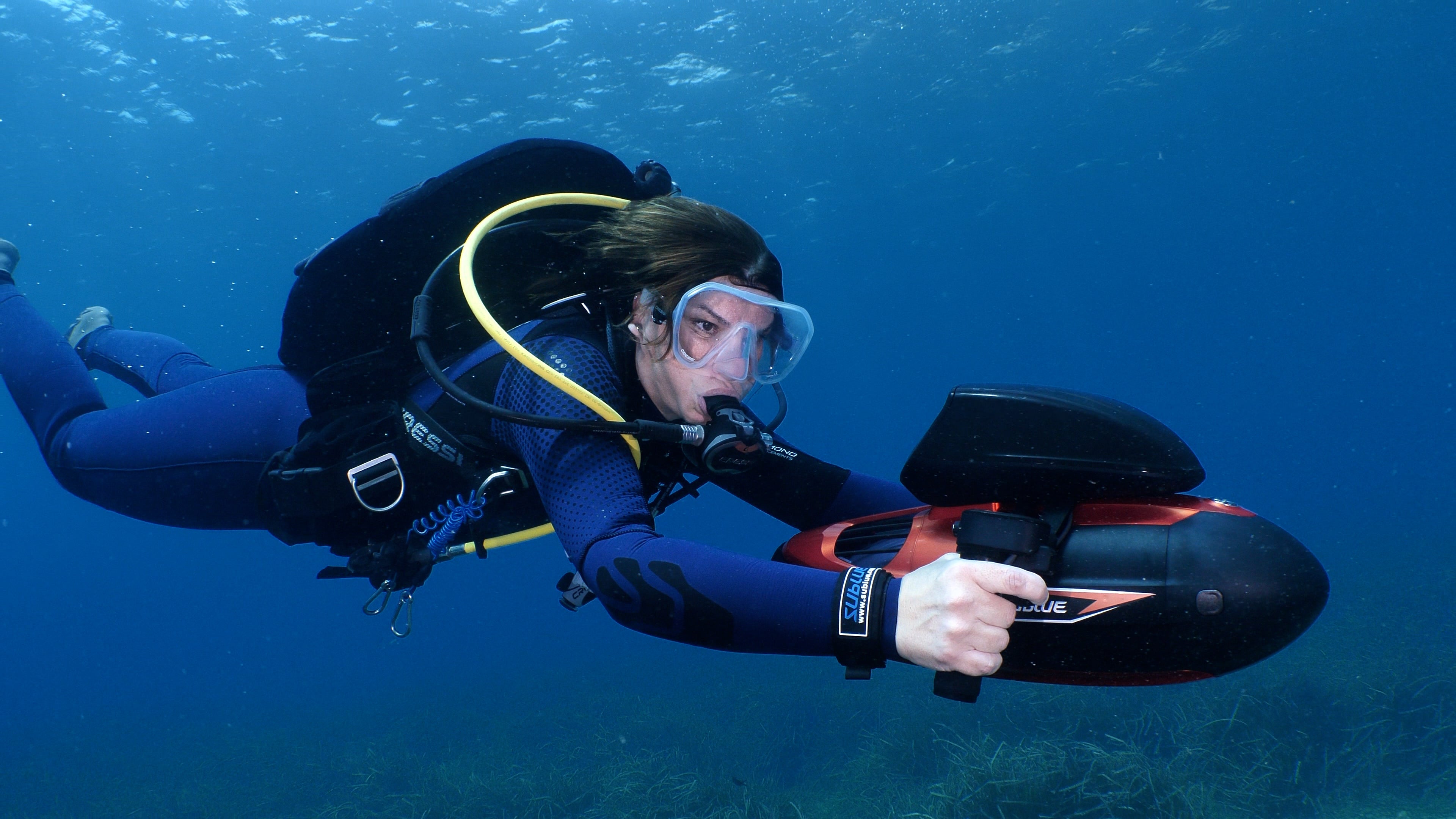

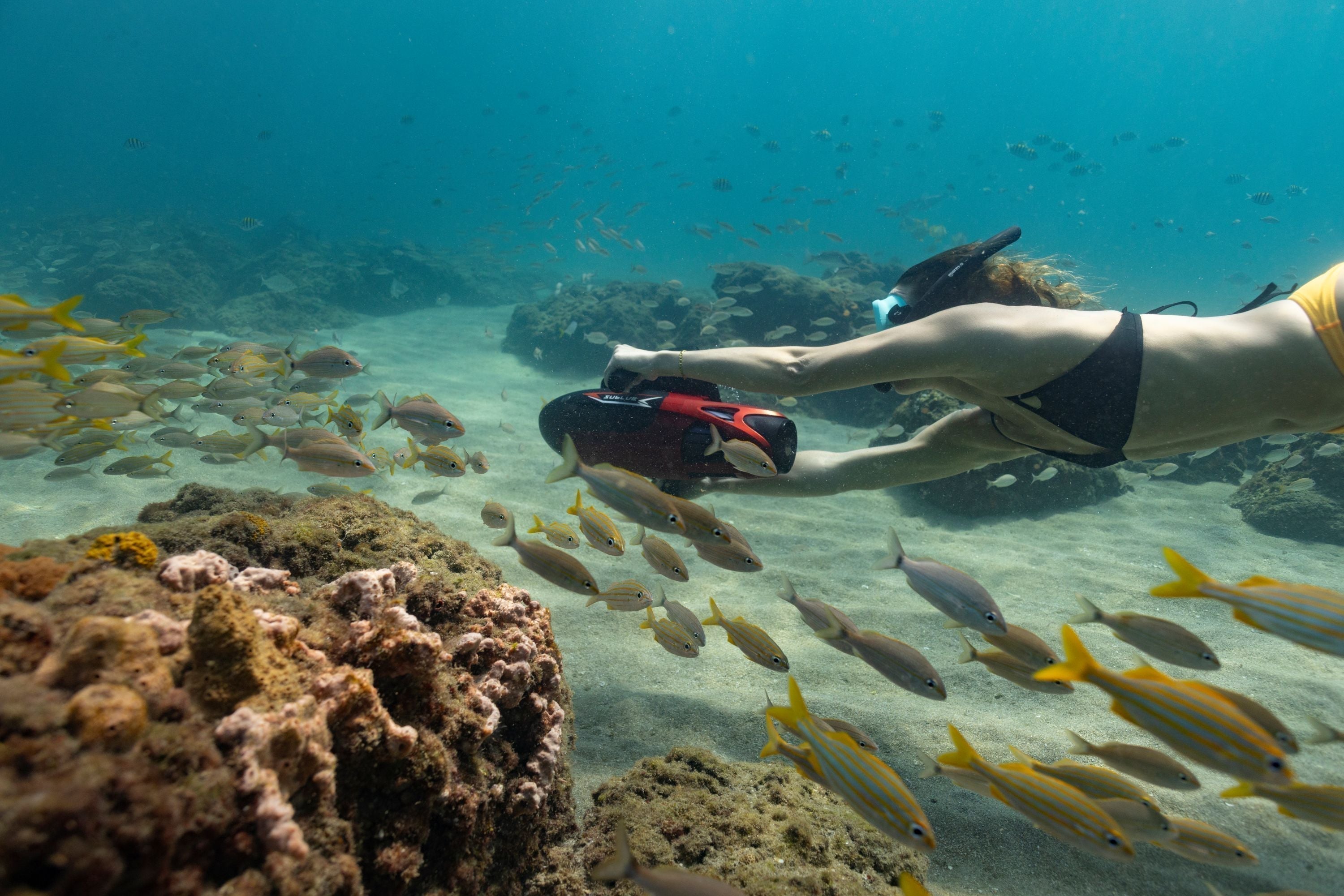
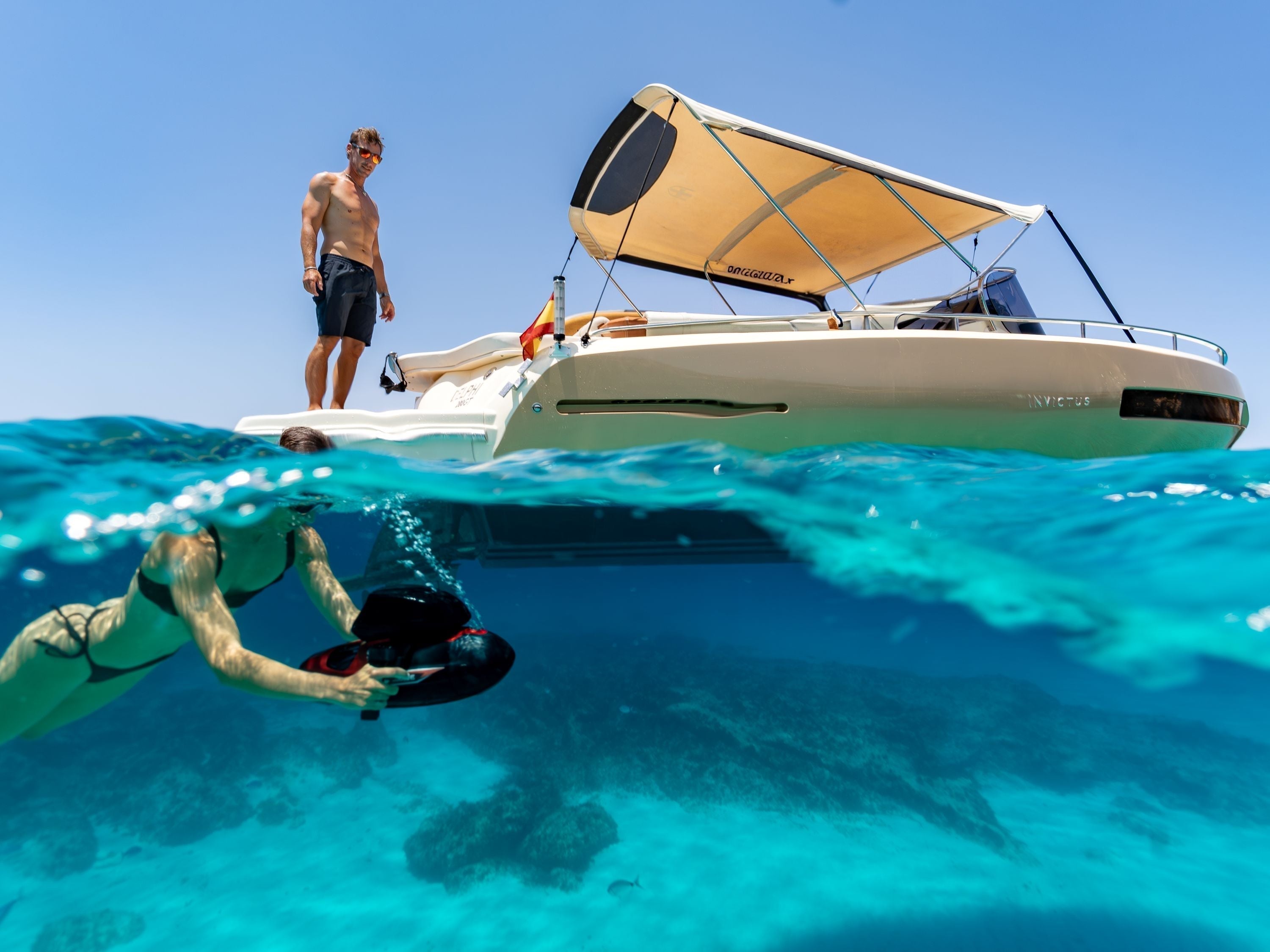




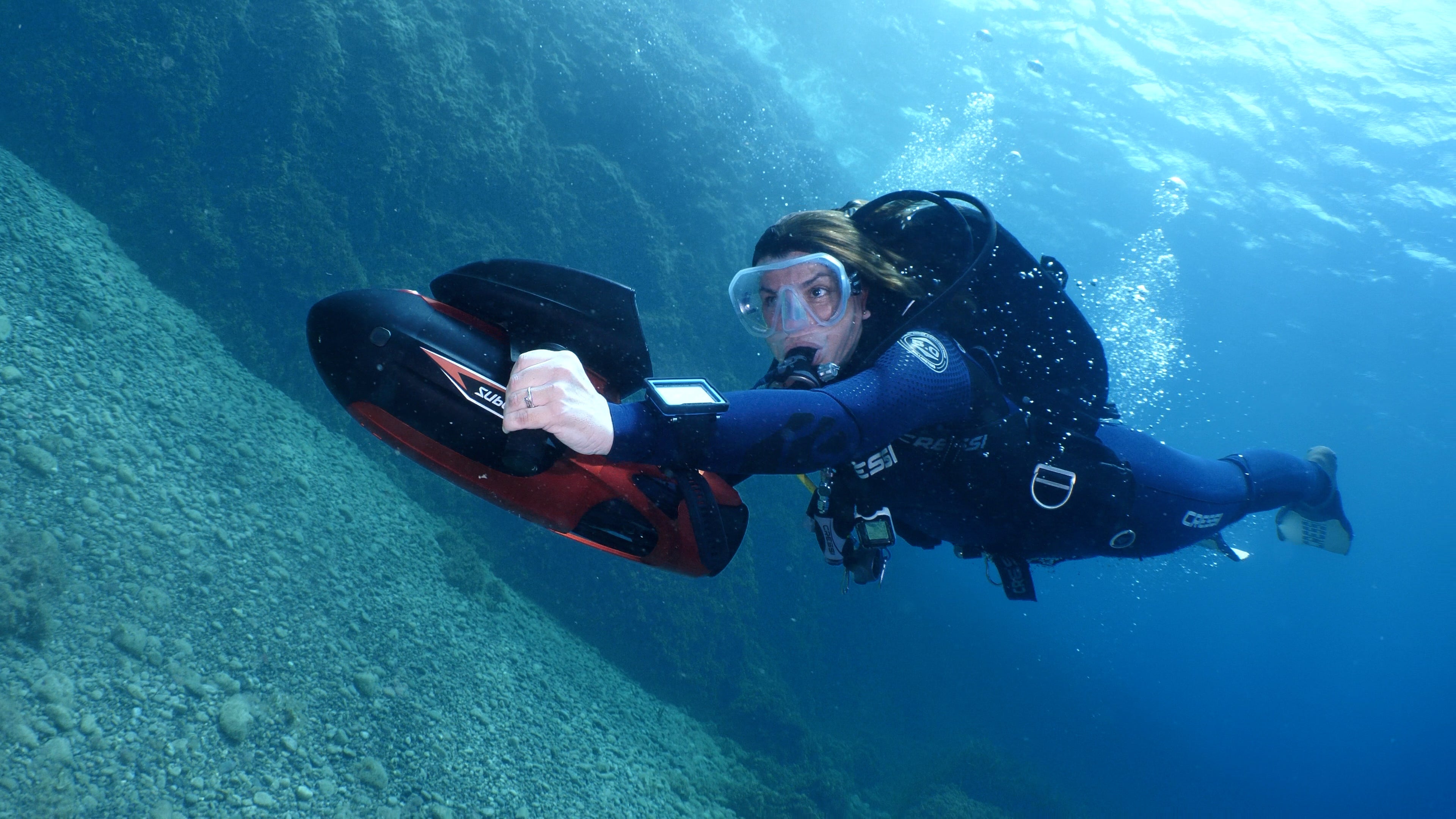
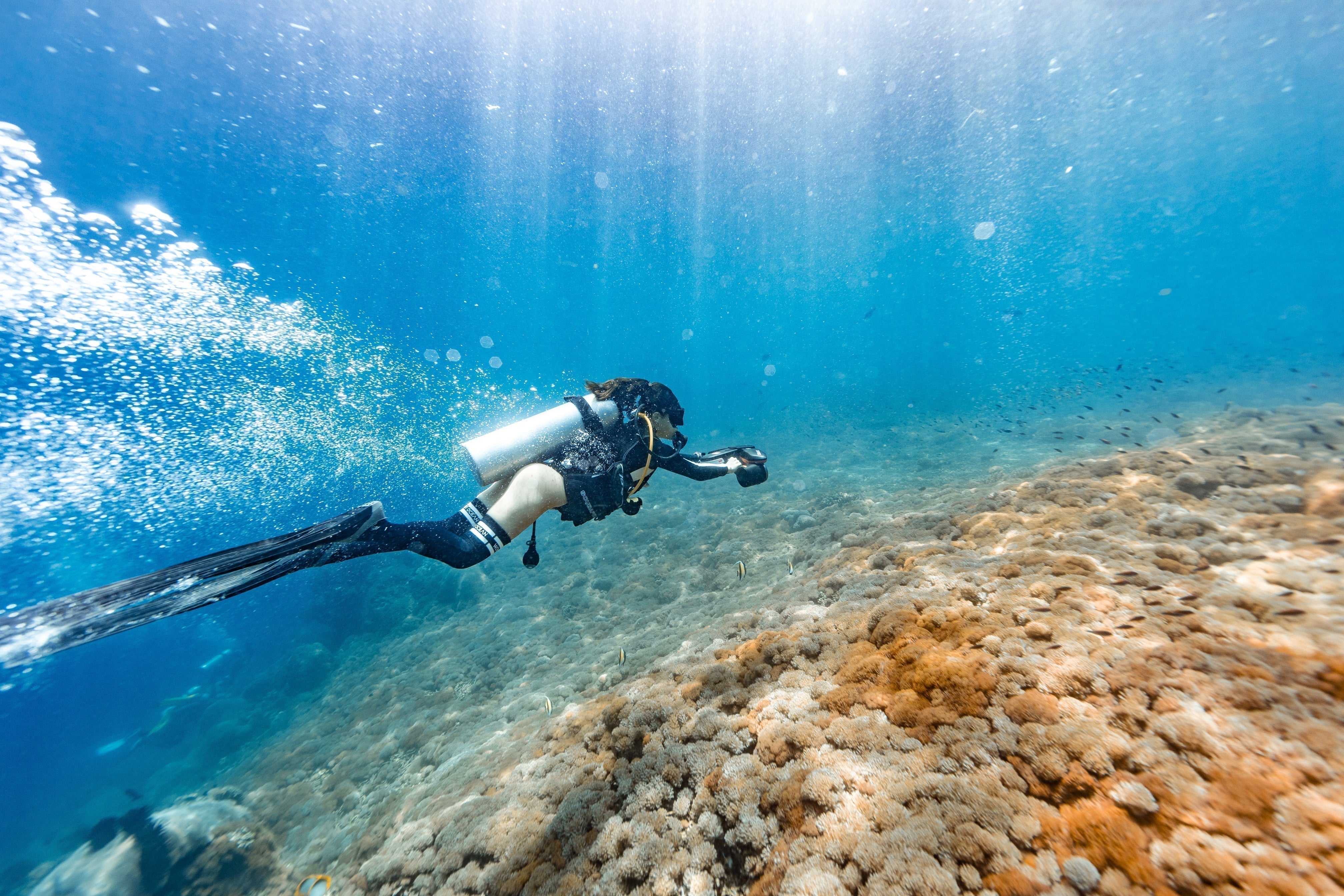
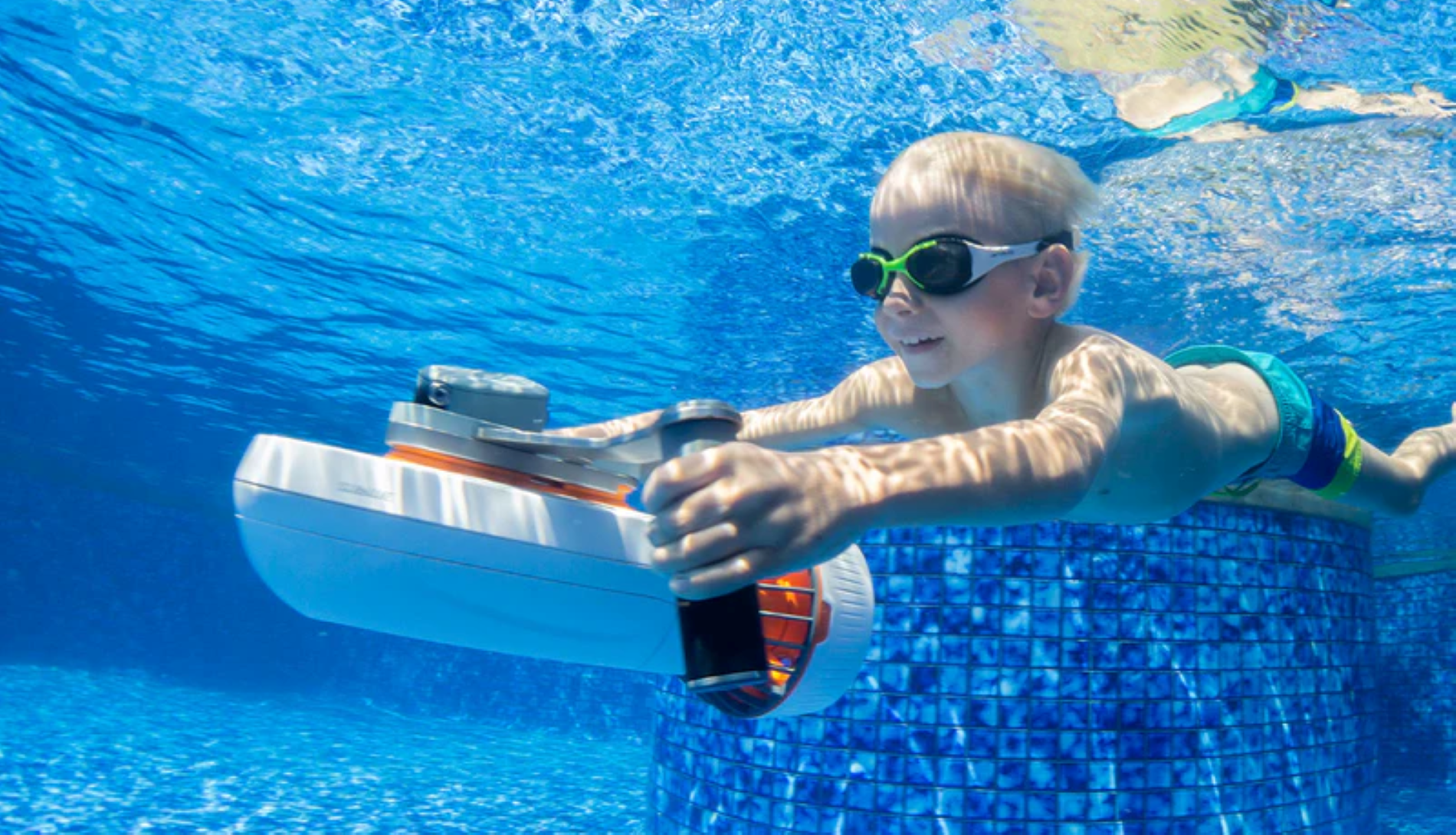
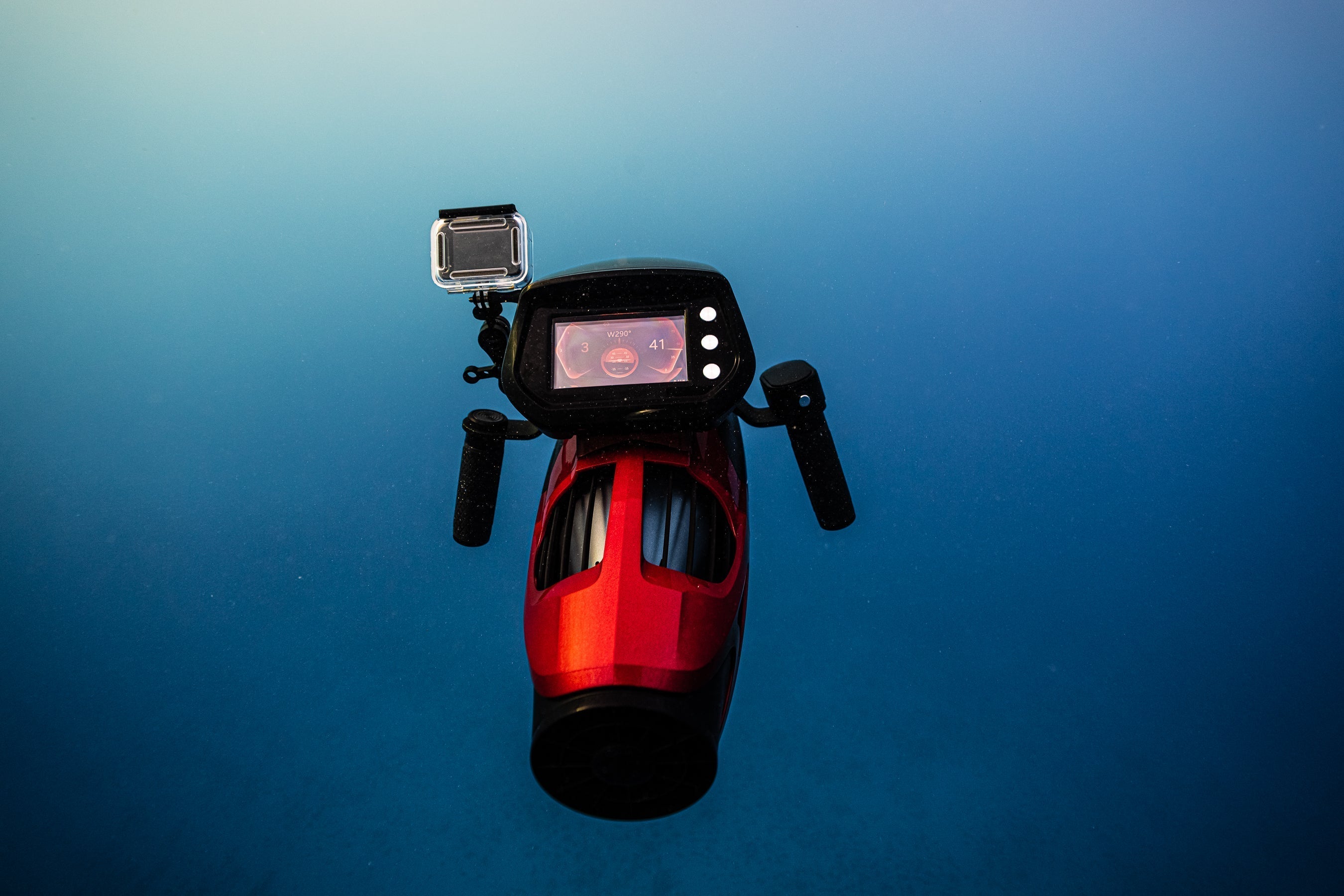
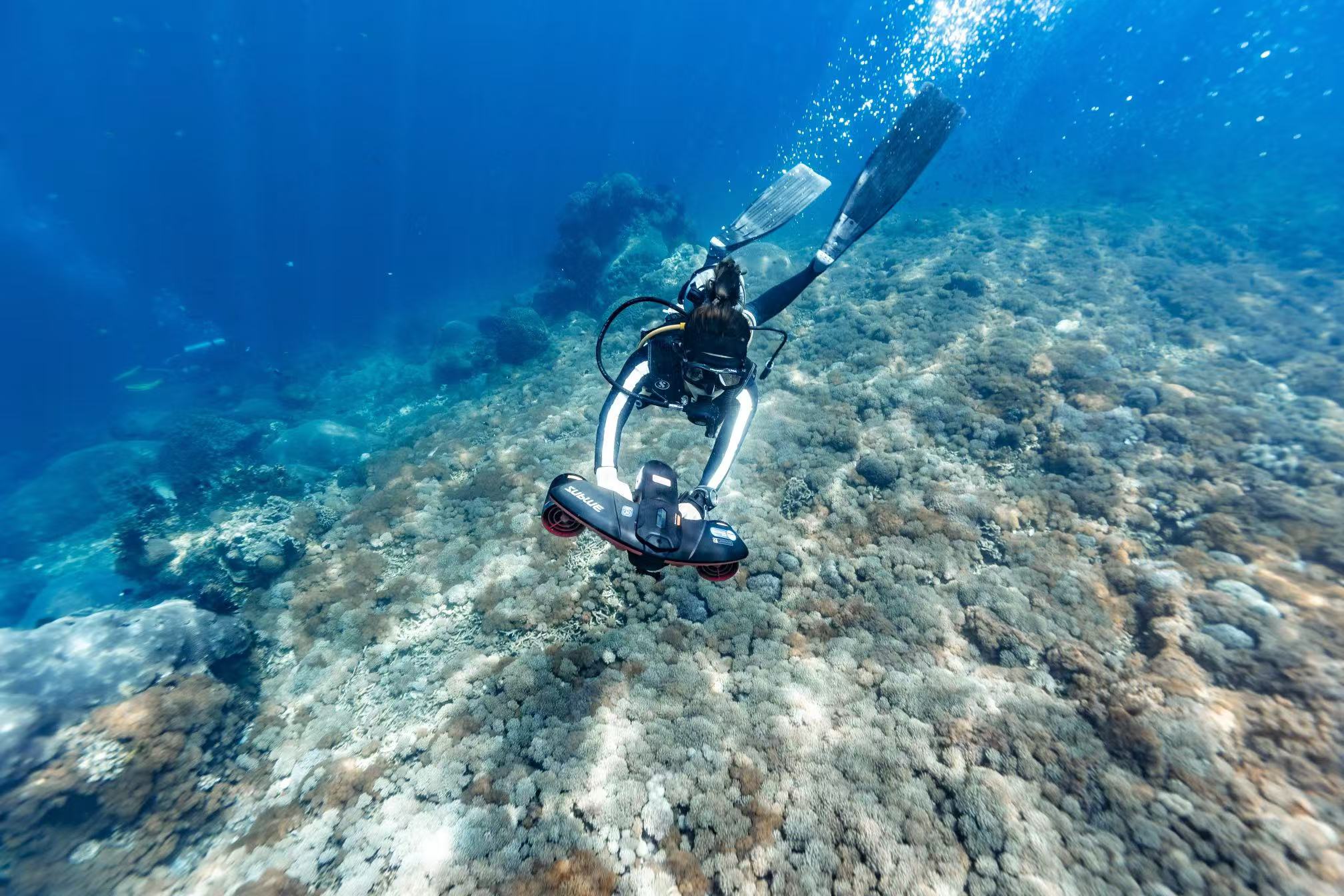
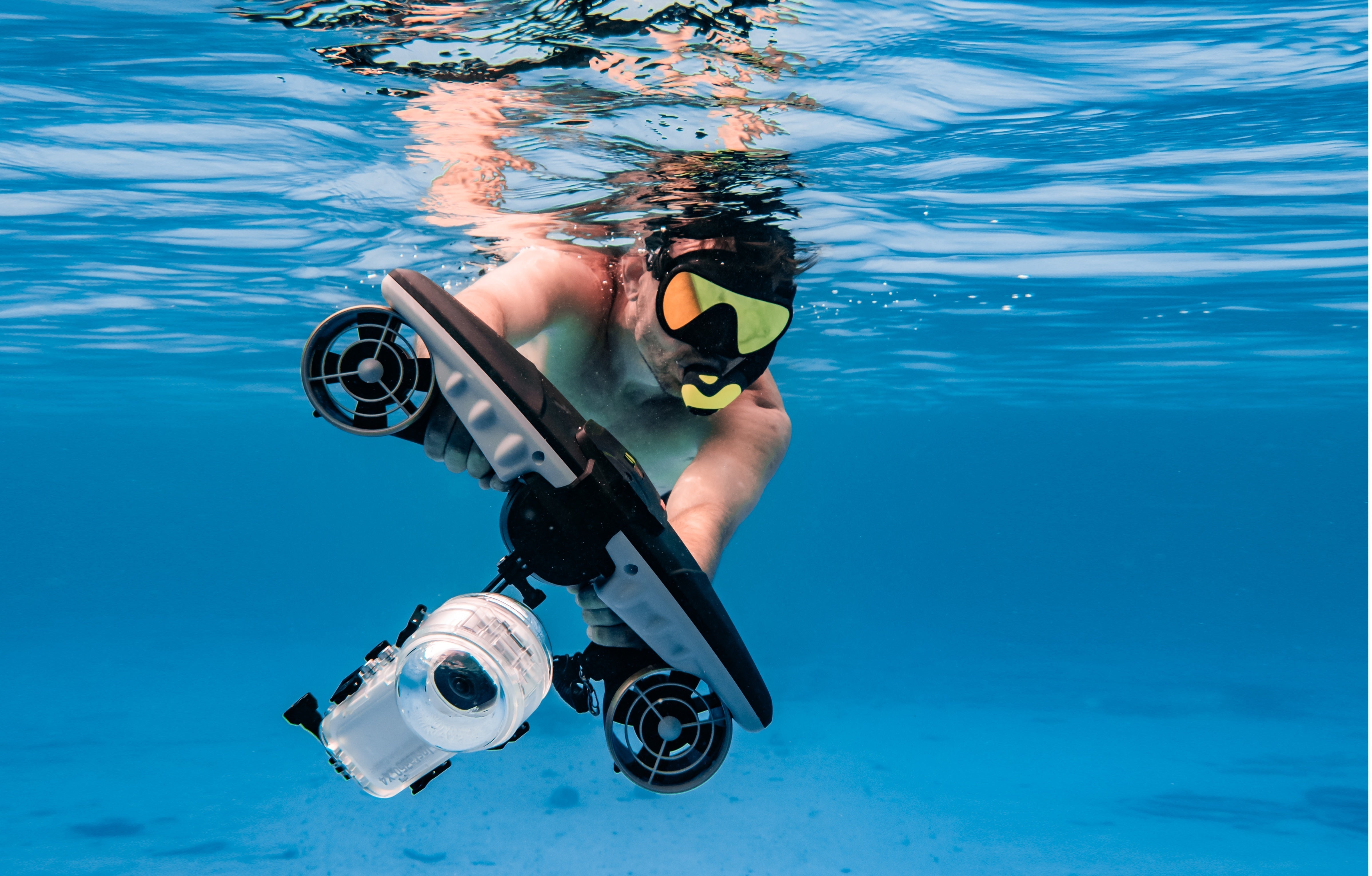
Distribuie:
Ghidul suprem pentru părinți despre distracția în familie cu scutere subacvatice
Ghidul suprem pentru videografii cu scooter subacvatic